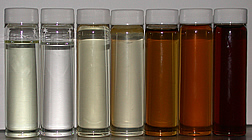This page has been archived and is being provided for reference purposes only. The page is no longer being updated, and therefore, links on the page may be invalid.
|
|
|
|
Fortifying Feed with Biodiesel Co-products
By Ann PerrySeptember 20, 2007
Biofuel research isn’t just a matter of finding the right type of biomass—corn grain, soybean oil, animal fat, wood or other material—and converting it into fuel. Scientists must also find environmentally and economically sound uses for the by-products of biofuel production. Agricultural Research Service (ARS) scientists Brian Kerr and William Dozier have done just that.
Current biodiesel supplies are often made from the triglycerides, or fat, found in soybean oil. But processing biodiesel from soybean oil also yields crude glycerin, also known as glycerol, which has a purity level of about 85 percent. It also contains small amounts of salt, methanol and free fatty acids. If glycerol is refined to 99 percent purity, it can be used in many products, including pharmaceuticals, foods, drinks, cosmetics and toiletries.
Kerr, Dozier and Iowa State University colleague Kristjan Bregendahl studied whether crude glycerin could be used to supplement the feed of laying hens, broilers and swine. They found that crude glycerin provided a supply of caloric energy that equaled or exceeded the caloric energy available in corn grain. Feeds containing up to 10 percent glycerin had little to no adverse effect on laying hen egg production or broiler body weight gain. Pig body weight gain, carcass composition and meat quality also showed little to no adverse change after equivalent levels of crude glycerin were added to their feed.
Safe levels for salt, methanol and free fatty acids in crude glycerin consumed by nonruminant livestock still need to be determined. But as corn grain ethanol production and conversion soar, corn grain supplies for livestock feed are decreasing. Using crude glycerin to supplement feed supplies could provide livestock producers with a readily available, inexpensive and energy- packed alternative to corn grain.
Kerr is an animal scientist at the ARS National Soil Tilth Laboratory, Ames, Iowa. Dozier is an animal scientist at the ARS Poultry Research Unit, Mississippi State, Miss. They presented their findings this week at the 68th annual Minnesota Nutrition Conference in Minneapolis, Minn.
ARS is the U.S. Department of Agriculture's chief scientific research agency.

